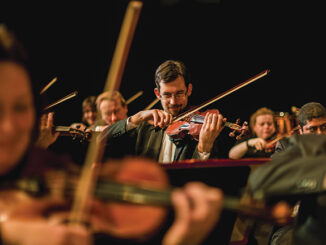
Once you have heard Mahler’s music, you’ll likely go back for a second helping. My first Mahler experience was the Fourth Symphony. The orchestration was amazing. The melodies unforgettable. A deep thinker wrote this music. It spoke of a yearning for some higher goal. At times it described wonderment, sometimes dismay and anguish. Whatever it was, I wanted more.
My next Mahler experience was, “Das Lied von der Erde” (Song of the Earth). This, too, had me glued to whatever medium I was using.
Here we have symphony and song – Mahler’s two major forms of writing. He was a master at both. Marveling at his “amazing work,” critic Deryck Cooke says Mahler’s music defies analysis. His music is sublime, but surprisingly Mahler’s friends were few.
At first it was his status as conductor that was without question. His music gained wide popularity only after periods of relative neglect. There was even a ban on its performance in much of Europe during the Nazi era. After 1945, Mahler’s works were rediscovered by a new generation of listeners. His compatriot Leonard Bernstein once implied that he had single-handedly rescued Mahler from oblivion. Also helping was the emergence of the late 1940s 33-1/3 long-playing record. I don’t think he ever wrote anything under 20 minutes in length.
Today, Mahler is among the most often played and recorded of all composers – classical and otherwise. BBC Music Magazine ranks three of his symphonies among the top ten of all time.
What is it about Mahler’s music? It draws you in. It paints stunning pictures. It seems to speak to our time. You may want to go back for more.
He was born to Jewish parents of humble origin in Bohemia, then part of the Austrian Republic on July 7, 1860. German-speaking Mahler displayed his musical gifts at a young age. His oeuvre is somewhat limited, because for much of his life writing music was part-time, as he earned his living conducting.
When he was four, Gustav discovered his grandparents’ piano and took to it immediately. His father Bernhard supported his son’s ambitions for a music career, and agreed that the boy should try for a place at the Vienna Conservatory. Gustav auditioned, was accepted, and made good progress, falling under the spell of Anton Bruckner and Richard Wagner’s music.
In 1880, Mahler took his first professional conducting job in a small wooden theater. The repertoire was operetta. In 1884 the distinguished conductor Hans von Bulow came to the area to give two concerts. Hoping to escape from his job at the theater, Mahler unsuccessfully sought a post as Bulow’s permanent assistant.
The next few years were marked by a succession of conducting posts, each one more prestigious than the former, and scoring a resounding success. This did not, however, win him popularity with the orchestras, who resented his dictatorial manner and heavy rehearsal schedules.
In 1888 Mahler found the time to sketch and complete his First Symphony. Also that year he discovered the German folk-poem collection, “Des Knaben Wunderhorn” (The Youth’s Magic Horn), which would dominate much of his compositional output for the next 12 years.
Mahler’s public profile as a conductor continued to rise, although behind the scenes it was clouded by hot disputes, resignations and dismissals. In 1892 he acquired a “komponierhauschen” (composition hut or retreat), and as a major ambition was now finishing his Second and Third Symphonies. An ultimate goal, however, was to win a conducting appointment with the Vienna Hofoper (Court Opera), winning it through a series of maneuvering, with the help of some influential friends.
Mahler was still quite young. The Viennese public held a general distrust of young artists. When he was named director of the Court Opera at 35 years of age, “a frightened murmur and astonishment ran through Vienna because someone had entrusted the highest institute of art to such a young person,” writes Austrian author Stefan Zweig.
In spite of many conducting triumphs, Mahler’s Vienna years were rarely smooth. There were battles with singers and the house administration. There were anti-Semitic elements in Viennese society, long opposed to Mahler’s appointment, who verbally attacked him relentlessly and started a press campaign to drive him out.
In May 1907 Mahler began discussions with the New York Metropolitan Opera. During his ten years in Vienna, Mahler had brought new life to the opera house and cleared its debts, but had won few friends. It was said that he treated his musicians in a way that a lion tamer treated his animals.
Mahler was now composing with great intensity. A trilogy of orchestral symphonies, the Fifth, Sixth and Seventh, were written between 1901 and 1905, and the Eighth in 1906. His works were being performed with increasing frequency.
In November 1901, Mahler met Alma Schindler. They married and had two daughters, Maria and Anna. Soon both daughters fell ill with scarlet fever and diphtheria. Anna recovered, but after a lengthy struggle Maria died. Mahler then learned that his heart was defective. A specialist ordered a curtailment of all forms of vigorous exercise. Alma wrote that her husband’s diagnosis was, to him, a “virtual death sentence.”
Mahler made his New York debut at the Metropolitan Opera on Jan. 1, 1908. It was a busy first season, and Mahler was widely praised. That year the Met management brought in the famed Italian conductor Arturo Toscanini. The two shared duties.
The 1909-10 season was long and taxing. Mahler’s programs were often too demanding for popular tastes. Mahler’s own First Symphony, given its American premiere that year, failed with critics and public alike. The season ended with heavy financial losses.
In spite of domestic and professional distractions, Mahler worked on his Tenth Symphony, completing the famous Adagio. In late October 1910 Mahler threw himself into a busy Philharmonic season of concerts and tours. In February 1911, with a temperature of 104, Mahler insisted on fulfilling an engagement at Carnegie Hall. It was his last concert. After receiving treatments for a number of ailments, Mahler died on May 18, 1911.
Alma Mahler survived her husband by more than 50 years, dying in 1964. A mix of enthusiasm, consternation and critical contempt was the normal response to Mahler’s music in the early 20th century. The one unalloyed performance triumph within Mahler’s lifetime was the premiere of his Eighth Symphony, in 1910, advertised by its promoter as the “Symphony of a Thousand.” At its conclusion, applause and celebrations reportedly lasted for half an hour.
Maybe they were demanding a second helping.
-by Lee Stott





